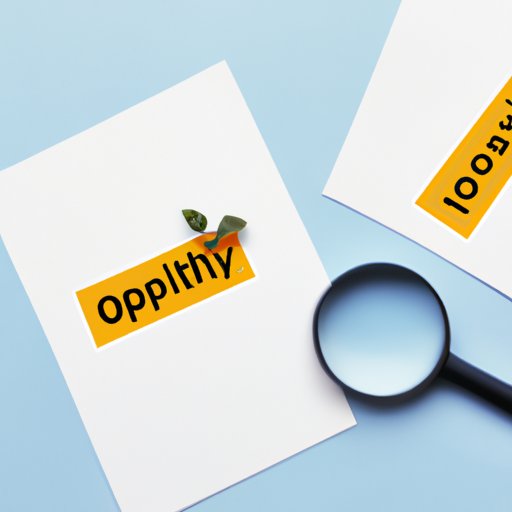
I. Introduction
Opportunity cost is a crucial concept for decision-making in personal and business contexts. It refers to the value of the best alternative forgone when choosing a particular option. In this article, we will provide an overview of opportunity cost, how to calculate it, why it matters, and how to minimize it.
II. Define Opportunity Cost
Opportunity cost is the value of the best alternative that must be given up in order to pursue a particular option. It’s the cost of any decision that comes at the expense of pursuing a different alternative. The concept helps individuals and businesses make informed decisions by weighing the pros and cons of each option.
For example, if a person chooses to invest in stocks instead of real estate, the opportunity cost is the value of the benefits he or she could have gained from investing in real estate.
III. Explore the Basic Calculation
To calculate opportunity cost, first identify the alternatives available and the benefits and costs associated with each. Then, subtract the benefits of the chosen alternative from the benefits of the next best alternative. The result is the opportunity cost.
For instance, consider a person choosing between going to college for a business degree or directly starting a business. The benefits of going to college include the potential for higher salaries and greater job security. The benefits of starting a business directly include the potential for greater control and profits.
Suppose the person chooses to go to college, and the total cost of college is $100,000. The expected salary after graduation is $60,000 annually, while the expected profit of starting a business is $100,000 annually. The opportunity cost of going to college is the forgone profit of $100,000 minus the expected salary of $60,000, which equals $40,000 annually.
Opportunity cost can be applied in different scenarios such as choosing between job offers, investing in different stocks or bonds, or selecting the optimal use of a resource like time or money.
Common mistakes when calculating opportunity cost are failing to consider all alternatives accurately, inaccurately assessing benefits and costs, and ignoring the time factor involved in comparing alternatives.
IV. Discuss the Importance of Opportunity Cost
Understanding opportunity cost is essential because resources such as time and money are finite, and every decision made has an opportunity cost. The concept of opportunity cost can help avoid making decisions that may have regrettable long-term effects.
For instance, failing to weigh the opportunity cost of choosing one investment over another could result in missed opportunities and financial losses.
Significant decisions made in personal and professional lives, such as career choices and investment decisions, involve considering opportunity costs.
For example, a business owner may consider the opportunity cost of investing in office space over production equipment or the opportunity cost of hiring employees versus investing in training.
V. Consider Economic Context
Opportunity cost is a fundamental concept in micro- and macro-economic theories and concepts. In macroeconomics, opportunity cost is a significant consideration in the allocation of resources in a market economy. Production possibilities frontiers, a graph that illustrates the trade-offs a society faces in choosing what goods and services to produce, is an example of an opportunity cost calculation at a macroeconomic level.
In micro-economics, opportunity cost is central to the concept of comparative advantage, which explains how nations can benefit mutually from trade. Understanding opportunity cost in economic contexts enables businesses to make better decisions that consider the short- and long-term benefit of their operations.
VI. Compare Trade-Offs
Comparing the opportunity costs of different alternatives can aid in decision-making that involves weighing up different trade-offs. Decision makers identify the opportunity costs of each alternative and determine which one is most beneficial to pursue.
For instance, a consumer considering purchasing either a car or a vacation can weigh the cost of owning a car with the potential benefits of experiencing different cultures and relaxation. When the cost of owning a car outweighs the benefits of owning one, choosing a vacation becomes a more desirable option.
VII. Discuss Time Value of Money
Time is a crucial factor to consider when calculating opportunity cost. The time value of money refers to the potential return on investment earned over time, which affects the opportunity cost calculation.
Opportunity costs can increase or decrease as time passes, depending on the rate of return on investments and inflation rate. The calculation of opportunity costs must, therefore, consider the potential value of money in the future and adjust for inflation and interest rates accordingly.
For instance, a person considering purchasing a home versus renting for a period must consider the opportunity costs of mortgages, maintenance, and taxes, as well as the potential appreciation of the property in the future.
VIII. Outline Strategies to Minimize Opportunity Cost
To minimize opportunity costs, individuals and businesses must optimize their decision-making methods. Strategies to minimize opportunity cost include performing thorough analysis of available alternatives, seeking expert advice, and maintaining flexibility.
In personal finance, strategies like diversification and active trading in stocks and bonds can help manage investment risks and maximize returns. In the business context, outsourcing underperformed activities and investing in employees’ skills can help improve efficiency and reduce opportunity costs.
Real-life examples of opportunity cost minimization include choosing virtual over physical meetings, which can reduce travel costs, and seeking long-term contracts or subscriptions rather than paying per use.
IX. Conclusion
Opportunity cost is an essential concept for decision-making that involves considering the value of forgone alternatives. By understanding the calculation, significance, and economic context of opportunity cost, individuals and businesses can make informed decisions and minimize the risk of regrettable outcomes by considering trade-offs.
By following strategies to minimize opportunity costs, decision-makers can optimize their decision-making methods and achieve their goals effectively.
Applying the knowledge gained from this article can help readers make better decisions in their personal and business lives.





